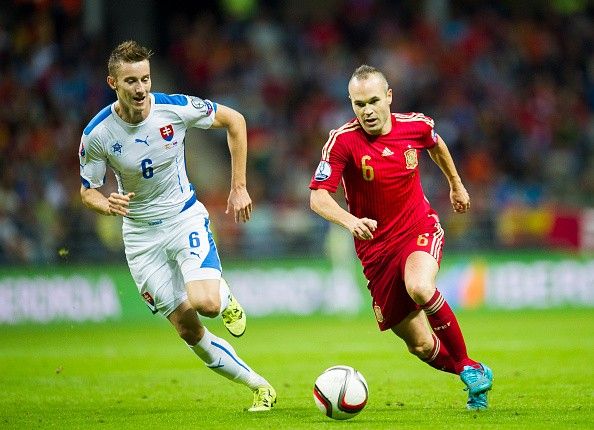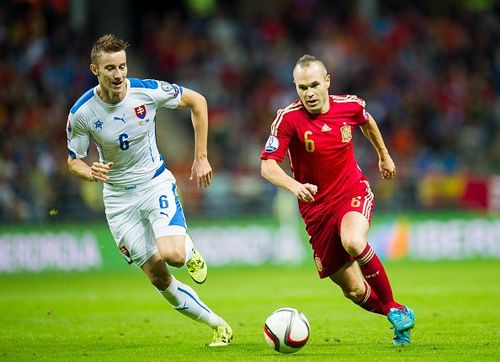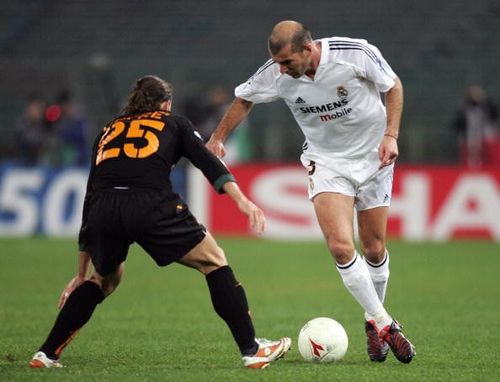
Andres Iniesta: Evoking memories of Zinedine Zidane

It was the usual Euro qualifier involving Spain. La Roja were bossing the game, making the Slovakians run around in circles while they played Total Football (yes, the left back Jordi Alba scored from a cross provided by midfielder David Silva). The whole affair seemed monotonously cruel for Hamsik and Co, and tired from watching such a boring version of injustice, I was about to fall asleep in my chair.
And then, it happened.
As the ball bounced off into no man’s land from a Slovakian free kick, Andres Iniesta received it. Alright, I thought, pass it back to a free teammate so that he can resume tiki-taka and I can go to sleep. But then, I’m no Iniesta. The Spanish magician instead opted to do a ‘roulette’, run into the empty space and nonchalantly pass the ball into the wings to spring an attack out of nowhere.
Now, I was awake.
Not because Iniesta had proved elusive to yet another defender or because he had so effortlessly converted a defensive situation to his team’s advantage – we are all pretty used to that, even though it’s a sight to behold every single time. No, it was the roulette – a move which, a decade ago, had been the trademark of another supreme footballer, whose stature at club and country was possibly epitomised by Iniesta now.
Has Don Andres really been the Zinedine Zidane of the past 10 years? The question was enough to keep me sleepless all night.
It’s all about the style
“Zidane is the master. Over the past 10 years, there's been no one like him, he has been the best player in the world.” – Pelé
“He dominates the ball, he is a walking spectacle and he plays as if he had silk gloves on each foot. He makes it worthwhile going to the stadium – he's one of the best I have ever seen.” – Alfredo Di Stefano
“Zidane is unique. The ball flows with him. He is more like a dancer than a football player.” – Franz Beckenbauer
“Technically, I think he is the king of what's fundamental in the game – control and passing. I don't think anyone can match him when it comes to controlling or receiving the ball.” – Michel Platini
On a football pitch, Zidane was a heavenly union between beauty and functionality in the shape of a human. Every dribble he made would be elegant yet effective. Every trick to beat a defender was graceful yet purposeful. Every seemingly-trivial body feint or cheeky pass was aesthetically pleasing yet deadly for the opposition.
His gameplay would raise the football fan above the action of merely watching 22 men running around on grass; it gave a grand, meaningful view of the football being played. The true measure of his stature in football can be taken from the fact that at Real Madrid he was the focal point of a team loaded with Galacticos, and constantly drew ‘ooh’s and ‘aah’s from the normally-unforgiving Santiago Bernabeu crowd – some of whom assembled pre-match just to watch him warm up.

Iniesta is perhaps what Zidane would have been in a 5’ 7” frame. The casual shirking off of defenders and expert manipulation of the ball while standing still would be replaced with a low centre of gravity and agility to evade opposition. Where Zidane used the pace of opposition players against them, Iniesta used his own mobile body to the same effect.
Where Zizou employed the roulette as a trademark move to shield the ball, Iniesta made the ‘La Croqueta’ move his own.
They may have been born in different bodies, but in spirit, Zidane and Iniesta are identical footballers – midfielders with flair. They rely on more than just pace to beat defenders, they can change games through their intelligence and mastery of the ball, and they are a joy to watch for fans and managers alike.
Zidane and Iniesta have similar career trajectories
It’s remarkable how similarly their careers have panned out as well. For starters, both of them, aged 26, were instrumental in winning the World Cup by scoring defining goals in the final to secure the ultimate honour for their national team.
They both followed it up by winning the Euros two years later. While Zidane led Les Bleus to a Euro win in 2000, La Illusionista became European champion with Spain in 2012. Both of them beat Italy in the final and, sure enough, both of them were adjudged UEFA Player of the Tournament.
Even at club level, Zidane scored one of the best goals in a Champions League final and in history generally: that volley against Bayer Leverkusen in the 2002 final at Hampden.
But equally so, Iniesta’s volleyed strike against Chelsea in the 2009 semi-finals at Stamford Bridge to tie the game 1-1, right on the edge of the penalty area (the same position from which Zidane beat Hans-Jorg Butt), wasn’t only superb, but also pivotal in helping Barcelona to the title in 2009.
The players are big, the men are bigger
More importantly, Iniesta’s influence and stature at Barcelona have assumed almost irreplaceable proportions, much like Zizou. This was evident in two of Barcelona’s recent matches – the UEFA Super Cup final where, after Iniesta’s substitution, the Catalans squandered a 4-1 lead, and the Supercopa de Espana in which Iniesta did not start in the first leg, resulting in a 4-0 loss for the Blaugrana.
This was reminiscent of the French national team in the early 2000s, which looked lost on its way to a first round exit in the 2002 World Cup without Zidane, but immediately looked a force to reckon with in the 2006 edition, when their talismanic midfielder put his retirement on hold to lead his team to the World Cup final in Germany.
At this rate, it might be safe to assume that Iniesta too will remain a pivotal player for club and country right up until his retirement. And although he is unlikely to end his career with a headbutt, there is a mighty good chance he signs off in a World Cup final.
The breathtaking ability of Andres Iniesta, respectfully nicknamed El Cerebro, is often overshadowed by the goalscoring brilliance of Lionel Messi and Cristiano Ronaldo. The roulette against Slovakia, however, will help me sleep safe in the knowledge that the spirit of Zidane still lingers.